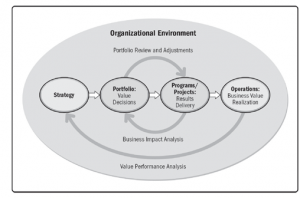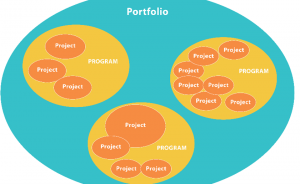1.2 Organizational Environment and the Project Environment
Organizational Environment
Executives select projects based on their potential value to their organization. Prioritizing projects in any organization depends on a number of factors such as strategy, economics, social, political situation, technology, competition and other environmental factors. The PMI Standard for Organizational Project Management (OPM, 2018), provides a framework by which organizations can achieve their strategic objectives by means of a portfolio, program and project management.
Selecting and prioritizing projects has to be aligned with the goals, values and strategy of the organization. For example if a core value of an organization is “customer focus” or “customer centered” then the activities selected for requirements, features and scope validation must reflect customer-focus approaches to create value for the stakeholders. This aligns with the idea of efficiently engaging with stakeholders to meet their expectation and optimize the value delivered.
Organization environment represents the organization governance, policies, organizational culture and supporting practices of the organization that are created to support OPM and organizational strategy delivery and the system must be set up for value delivery.

Adapting to the unique objectives, stakeholders, and complexity of the organization environment contributes to project success or failures. The PMBOK 7th edition discusses ‘tailoring’ which is the deliberate adaptation of approach, governance, and processes to make them more suitable for the given environment and the work at hand. Tailoring involves understanding the project context, goals and operating environment. It encourages project leaders to tailor their approach to the challenge that they are tackling, the work that they are doing, the team that they are engaged with and the context within which they are working.
Effective project management and execution start with choosing the right projects. While you might not have control over which projects your organization pursues, you do need to understand why your organization chooses to invest in particular projects so that you can effectively manage your projects and contribute to decisions about how to develop and, if necessary, terminate a project. It is important to start with the definitions:
Product: Is an artifact that is produced, is quantifiable, and can be either an end item in itself or a component item.
Project: A temporary endeavor undertaken to create a unique product, service or result.
Program: Related projects, subsidiary programs, and program activities that are managed in a coordinated manner to obtain benefits not available from managing them individually.
Portfolio: Projects, programs, subsidiary portfolios, and operations managed as a group to achieve strategic objectives.

It is important to understand the similarities and differences amongst portfolio, program and projects since the management of portfolios, programs and projects are driven by organization strategies. However, they interact at different levels to achieve strategic goals and objectives.

Projects are best if there is one primary goal for the project to focus on delivering; multiple goals are best dealt with by way of a program, with a series of projects each focusing on a particular goal.
It is also important to understand the concept of ‘product’ – which is an artifact that is produced, is quantifiable and can be either an end item in itself or a component item. Product management may initiate programs or projects at any point in the product life cycle to create or enhance specific components, functions or capabilities. Product management is a separate discipline with its own body of knowledge representing key integration point within the program management and project management disciplines.
The value delivery system is a new concept introduced in the standards section of the PMBOK 7th edition. Being very successful in completing a project does not always mean that organization’s strategies also achieve success. You may have produced more than one product as a result of successive successful projects, but this does not mean that you added value to the company.
According to the value delivery system, the strategies, goals, and tasks that an organization decides, drives the portfolio, programs, and projects that are carried out by the organization. These must be considered holistic, reviewed, and aimed at adding value to the organization.
The results of completed projects are evaluated, measured and analyzed to determine whether the expected impact has occurred. According to the results of this analysis, the portfolios owned by the organization are updated to create the highest value for the organization.
As long as the product or delivery included in the scope of the project was produced, the question of whether the targeted value was achieved remained somewhat ambiguous. In every project a benefits realization happens in the short term or long term. In a value management system, this benefits realization should be measured precisely and important value decisions should be taken according to feedbacks from operations, projects results, programs, and portfolios. In order to be able to do this, we have to build feedback loops into the system. Feedback is collected at the end of every project and these are used for value decisions at the portfolio level.
Project Environment
Project leaders who are able to effectively understand the environment in which they are operating can not only refine their approach to tailoring the tools and techniques required, they can also significantly increase the likelihood of successfully delivering change.
There are many factors that need to be understood within a project environment this can be classified as internal and external factors.
Internal factors can arise from the organization itself, a portfolio, a program, another project or a combination of these.
External factors can enhance, constrain, or have a neutral influence on project outcomes. See examples:
| Internal Factors | External Factors |
| Process Assets | Market place conditions |
| Government documentation | Social and cultural influences and issues |
| Data assets | Regulatory environment |
| Knowledge assets | Commercial databases |
| Security and safety | Academic research |
| Organizational culture , structure and governance | Industry standards |
| Geographic distribution of facilities and resources | Financial Considerations |
| Infrastructure | Physical environment |
| Information technology software | |
| Resources availability | |
| Employee capability |
The cultural and social environments consider people, demographics, and education. It is about understanding the cultural differences of unique countries and the impact that local and national governments have on organizations. The physical environment is about working conditions and locations. Delivering a project that has global impacts is much more challenging than delivering a project that only impacts the local environment.
Of all the factors, the physical ones are the easiest to understand, and it is the cultural and global factors that are often misunderstood or ignored. How we deal with clients, customers, or project members from other countries can be critical to the success of the project. For example, North American cultures value accomplishments and individualism, and tend to be more informal, calling each other by first names, even if having just met. Europeans tend to be more formal, using surnames instead of first names in a business setting, even if they know each other well. In addition, their communication style is more formal than in the North American setting, and while they tend to value individualism, they also value history, hierarchy, and loyalty.
How a product is received can be very dependent on international cultural differences. For example, in the 1990s, when many large American and European telecommunications companies were cultivating new markets in Asia, their customers’ cultural differences often produced unexpected situations. Western companies planned their telephone systems to work the same way in Asia, as they did in Europe and the United States. But the protocol of conversation was different. Call-waiting, a popular feature in the West, is considered impolite in some parts of Asia. This cultural blunder could have been avoided had the team captured the project environment requirements and involved the customer.
Project leaders in multicultural projects must appreciate the cultural dimensions and try to learn relevant customs, courtesies, and business protocols before taking responsibility for managing an international project. A project leader must take into consideration these various cultural influences and how they may affect the project’s completion, schedule, scope, and cost.
Other key consideration in understanding project environments – include operational and project management processes, policies, procedures, success metrics, and knowledge repositories. The degree to which they are utilized in a project, as well as the expectations surrounding their use, have a big impact on how projects are delivered.
